The Japanese Bento Box is the ultimate meal prep, consumed by millions of Japanese people every day. Today’s bento recipe is Tonkatsu Bento (Japanese pork schnitzel). It is intended to be eaten at room temperature, as everyone does in Japan.
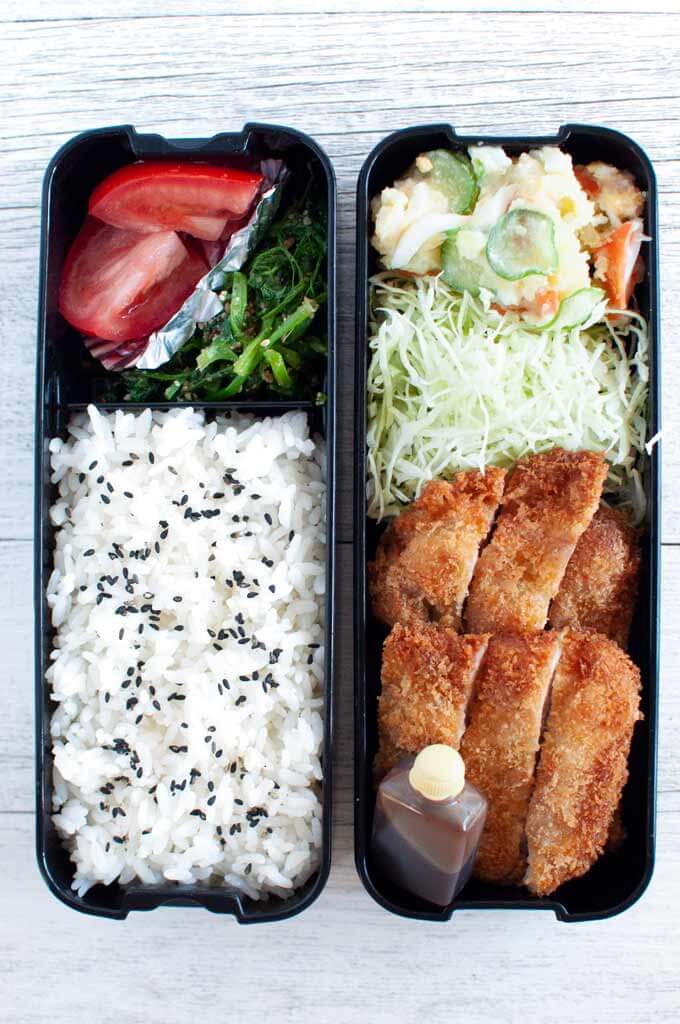
Bento (弁当) is a single portion meal packed in a container. The bento box is the container for the meal (so basically a lunch box) and it is called ‘bento-bako” (弁当箱) in Japanese. The word ‘bako’ is the same thing as ‘hako’ (箱), which also means box (it sounds easier to say ‘bako’).
Japanese people do put a lot of effort into making good looking and delicious bento. If you have travelled Japan, you probably encountered many different kinds of bento boxes sold at supermarkets, bullet train stations, department stores and convenience stores. They are made so pretty and appetising.
A home-made bento box is no exception. Small portion of various dishes are packed in a container together with rice. It is meant to contain balanced foods and whoever is making a bento box does it wholeheartedly.
Some home-made bento boxes are works of art, with cartoon characters created using the ingredients in the bento boxes. They were initially made for school kids to try to make bento more interesting and to encourage children to eat food even if they may not be fond of it.
It is called ‘kyaraben’ (キャラ弁) that is a shortened form of character bento expressed in Rōmaji. If you Google search images of ‘kyaraben’, you will be amazed at what people do to bento boxes.
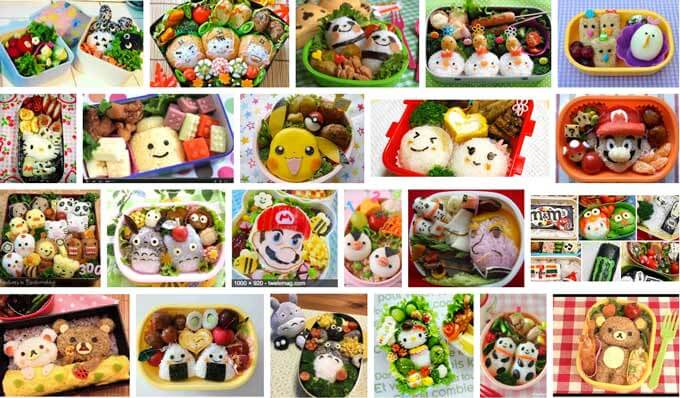
My bento box today is not a kyaraben but a standard bento with Tonkatsu as a main.
Bento is usually packed after dinner the day before it is to be eaten. Often, the ingredients are the left-overs from the meal, plus a couple of make-ahead dishes.
Tonkatsu Bento Ingredients
Ingredients for today’s Bento Box are listed below. I also added a note for variations.
- Cooked rice – this can be made ahead. Please refer to How to Cook Rice the Japanese Way. Pack cooked rice in a bento box while rice is still hot or warm as it is easier to shape it, and let it cool down before adding other ingredients.
- Tonkatsu – left over from dinner or make ahead. This can be chicken or fish cutlet instead.
- Shredded cabbage – left over from dinner or freshly made. Tonkatsu goes well with cabbage but lettuce is also good.
- Japanese Potato Salad– make ahead. I omitted sliced ham so that the potato salad can keep for a few days in the fridge.
- Snow Pea Shoots Goma-ae – make ahead. Please refer to Chrysanthemum Leaves Goma-ae to make goma-ae. I used snow pea shoots instead of chrysanthemum leaves. You could also use spinach to make goma-ae.
- Tomato wedges to add bright colour to the bento. Any other fresh veggie or even a small piece of fruit can be added here as an alternative.
- Black sesame seeds with salt sprinkled on the rice – I thought the rice area looked bare, so I added black ‘gomashio’ (胡麻塩, sesame seeds and salt). Other options include shredded roasted seaweed, furikake (rice seasoning) or umeboshi (pickled salty plum) that are mentioned in How to Cook Rice the Japanese Way.
- Tonkatsu sauce – fruity sauce perfect for tonkatsu. I buy the Bulldog bland tonkatsu sauce that I talked about in Yakisoba.
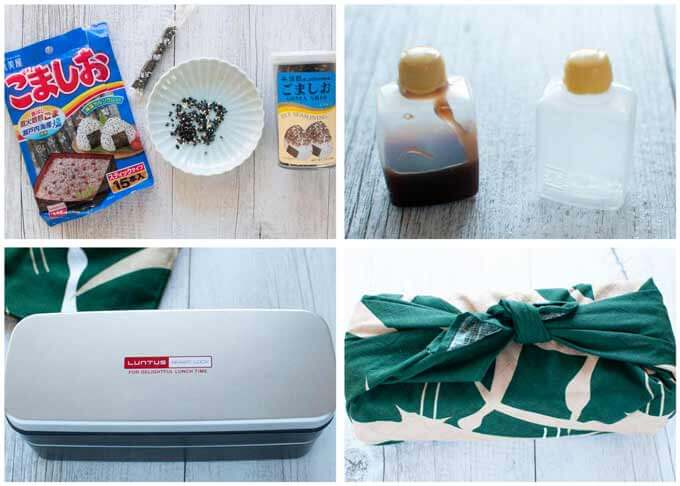
From top left clockwise: Gomashio (black sesame seeds and salt), Tonkatsu Sauce in a small plastic bottle, Bento box wrapped in a Japanese fabric wrapper, Double decker bento box.
Note 1: Gomashio (sesame seeds and salt) is sold at Japanese/Asian grocery stores. They come in either sachets or a bottle as you can see in the top left photo above.
Note 2: I had a tiny plastic sauce bottle that snuggly fit in the corner of the bento box (see the top right photo above). I bought this at a Japanese grocery store. Similar small plastic bottles can also be purchased at Daiso. But you can use a small sealed plastic container instead.
Today, I used a double decker bentō-bako (lunch box) that I bought in Japan (see the photos above). There are so many different bento boxes sold at Stores in Japan and some Japanese people have collection of bento boxes! You can of course use a normal take out plastic boxes instead.
Balance Is the Key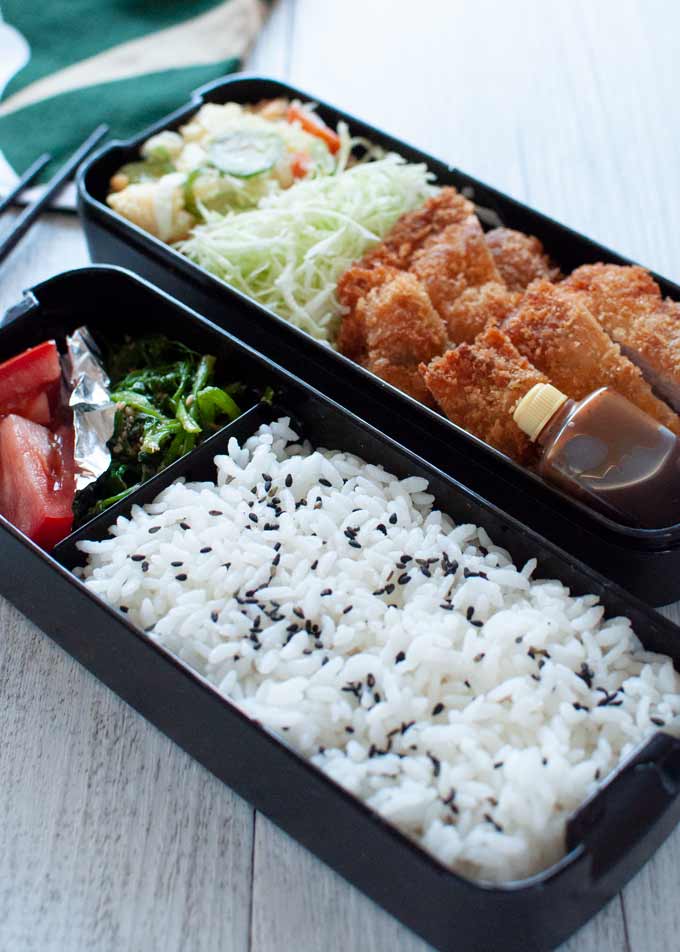
When making a bento, think about the following and imagine where to place which food in a box and how much:
- 5 colours – in my Tonkatsu Bento Box, I have white rice, green snow pea shoots & cucumber, red tomato, yellow egg yolk and brown cutlet.
- Sweetness + saltiness + sourness – in my bento box, goma-ae is sweet, gomashio is salty and potato salad is sour.
- Protein as main + sides.
- Utilise make-ahead side dishes – in my bento box, potato salad and goma-ae are make-ahead.
Traditionally, bento is meant to be eaten at room temperature without re-heating. Freshly cooked hot tonkatsu no doubt tastes wonderful. But even if tonkatsu is not hot at all, it tastes great when packed in a bento box with some other dishes.
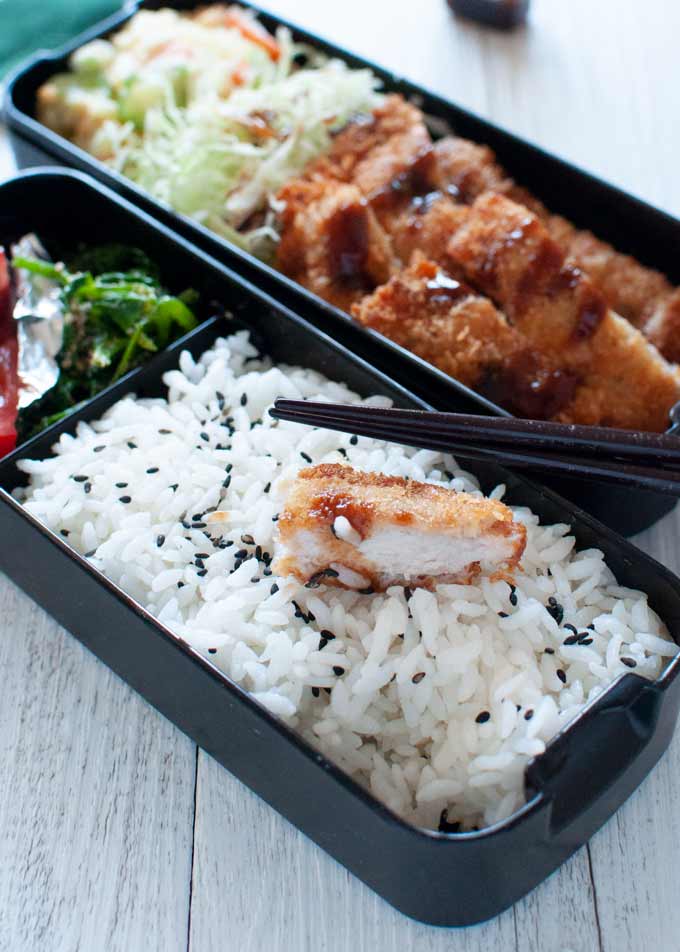
I don’t know what it is, but a bento box always gives me a smile when placed in front of me, even before opening the lid to see what’s inside. Finding out what’s inside of the bento box is almost like opening a treasure box.
Yumiko![]()
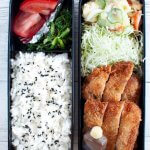
Bento Box with Tonkatsu as a main is called Tonkatsu Bento. It consists of cooked rice, tonkatsu and a small amount of a few side dishes. It is intended to be eaten at room temperature.
I have written my instructions on how to pack the box to make it look like the photo of the bento box in the post. But you don’t need to place the ingredients in the same way.
Because bento is usually made mostly from the left-over dishes or make-ahead dishes, the time indicated in this recipe only shows the time to pack the bento box.
- 1 cup cooked rice (note 1)
- 50g/1.8oz Goma-ae with snow pea shoots (note 2)
- 2 tomato wedges
- 50g/1.8oz Japanese Potato Salad
- A handful of shredded cabbage
- 100-150g / 3.5-5.3oz Tonkatsu cut into 2cm/¾" wide strips (note 3)
- Black sesame seeds with salt (optional, note 4)
- Bulldog tonkatsu sauce in a tiny bottle/jar/container (note 5)
- A bento box of your choice (I used a double decker bento box)
- A mini foil cupcake liner (note 6)
-
While the rice is still hot or warm, place the rice in the bento box and let it cool.
-
Put snow pea shoots goma-ae in a foil cupcake liner and place it next to the rice.
-
In a small space next to the cupcake liner containing goma-ae, place tomato wedges.
-
Place the potato salad at one end of the box.
-
Place shredded cabbage next to the potato salad, allowing sufficient space for the tonkatsu to fit in.
-
Place the tonkatsu pieces to fill the box.
-
If the container of tonkatsu sauce is small enough to fit in the corner of the bento box, put it in the box. Otherwise, pack it separately.
1. It is best to pack cooked rice in a bento box while hot or warm as it is easier to shape the rice into the bento box.
2. The recipe referenced here uses chrysanthemum leaves but I used snow pea shoots instead. Unlike chrysanthemum leaves, it is difficult to align the stems, so I simply spread the blanched shoots and cut to 4cm/1½” long.
3. Instead of pork, you can use chicken or fish fillet if you like.
4. I sprinkled black sesame with salt simply because the rice looked bare without something on it.
Other options include shredded roasted seaweed, furikake (rice seasoning) or umeboshi (pickled salty plum). I mentioned furikake and umeboshi in How to Cook Rice the Japanese Way.
5. Bulldog is a Japanese brand that is famous for sauces. Tonkatsu sauce is a thick fruity sauce that goes well with tonkatsu. The details and a photo of Bulldog sauces can be found in my post Yakisoba.
Sauce container - I bought a pack of small plastic sauce bottles from a Japanese grocery store. It’s like the plastic soy sauce bottle in tiny fish shape that you get at sushi roll shop. Similar tiny plastic bottles are sold at Daiso as well, if you are interested.
6. When I have two different foods that can easily integrate if placed next each other (e.g. one item is saucy), I often put one of them in a small foil cupcake liner (goma-ae in this case). Instead of a cupcake liner, you can also use a small sheet of aluminium foil to segregate two items.
Forgot to add a review
I tried making the bento box. It took me a while to make all of it but I made a video and uploaded it to YouTube. Thanks for writing the recipe in a really detailed manner. The part I struggled with the most was the Goma-ae but everything else came out really tasty!
Yumiko if you have any copyright problems with me making your recipe please let me know and I’d be happy to take down the video.
https://www.youtube.com/watch?v=gILP8defx1E&ab_channel=SashaFei
Hi, Sasha. Well done! Your bento looks great. Next time when you want to make a bento, put a small amount of side dishes (or even main if suited) aside from the previous day. Then you will spend less time to pack the bento.
I have no issues with your video.
Hello Yumiko,
My name is Sky and I’d like some advice.
I’d like to create a beginner friendly bento for my future husband (currently boyfriend). What should I do?
Thank you Yumiko.
Hi Sky, the tips are (1) easy flavoursome dish for a main, (2) utilise make-ahead dishes, (3) make use of rice seasoning to decorate the rice, and (4) avoid dishes with liquid.
Teriyaki Chicken is easy to make. You can cook it for dinner and put aside for a bento to be packed next day. You can see the sample bento here. My Teriyaki Chicken bento has Dashimaki Tamago (rolled omelette), but you can pack halved boiled egg instead. Instead of Simmered konbu, you can blanch spinach and pack with a bit of soy sauce and bonito flakes if you have (see the recipe here).
I am looking forward to preparing your recipes.
Hi Caroline, preparation is the second best part of the cooking for me, especially when the final dish looks great and tastes perfect. The best part is to see the diners happy face when they eat my food. Enjoy!
Bautiful bento box and delicous recipes, thanks for sharing
Hi Bentomania, thanks! You have many bento boxes on your sales site!
This comment is a golden nugget. Just learned of Bentomaniac.com from here. It’s jungle on Amazon 😉
Great!
We are based in Lae, Papua New Guinea. There are many OZ in this city. So we have a plan to open Bento Take-away shop and catering service very soon.
Thank you for providing easy recipe especially my PNG wife is easy to understand…
Hi Russel, that’s very exciting! I wish you a good luck.